These maps were developed by the GIS students at Niagara College in 2013. Some of the trails have since been slightly changed. Sorry for any inconvenience.
Overview of Park Map
Our Trails
- #1 Swayze Falls
- #2 Black Walnut
- #3 Palaeozoic Path
- #4 Scarlet Tanager
- #5 Hemlock Valley
- #6 Terrace Creek
- #7 Very Berry Trail
Helpful links to enjoy the park:
- Ontario Parks Website
- AllTrails App Entries Please note that some trails shown on this App are not designated park trails. Please remain on the established trails.
- Ontario Hiking Article
Guidelines for a Pleasant Visit
Trail Etiquette
Code of Ethics

SWAYZE FALLS
Trail Type: Shared Use
Trail Marker: Yellow # 1
Trail Length: 6.2 km (3 hours)
Trail Difficulty: More Difficult
The Swayze Falls Trail is a shared use trail to accommodate hikers, horseback riders and mountain bikers. This natural terrain trail can be accessed from the Pelham Road or Roland Road entrances. Some of the most notable features along the trail include Swayze Falls, natural vegetation including Sugar Maple, Black Maple, and Black Walnut. The Swayze Falls Trail loops through both fields and forests.
Please Note: This trail was re-routed in the summer of 2012. Our current printed trail guides still show the old trail in north section. The map on this page is a current trail map.
BLACK WALNUT
Trail Type: Shared Use
Trail Marker: Yellow # 2
Trail Length: 4.3 km (2 hours)
Trail Difficulty: Steep Hills and Uneven Ground
The Black Walnut trail can be accessed from the Wiley Road and Pelham Road entrances. This natural terrain path is a shared use trail through many scenic valleys. Horseback riders and mountain bikers will find this trail to be a moderate ride. Some of the notable features along this trail include several old roads, mixed hardwood and coniferous vegetation, and a variety of wildflowers including Birdsfoot Trefoil, and Common Milkweed. This trail loops through the eastern section of the park. It parallels a section of the Bruce Trail, winds around Twelve Mile Creek, follows an old farm road, and joins the Swayze Falls Trail at the central kiosk.
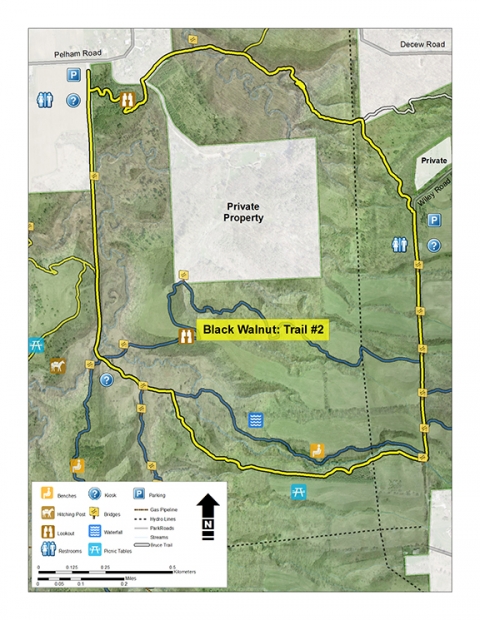
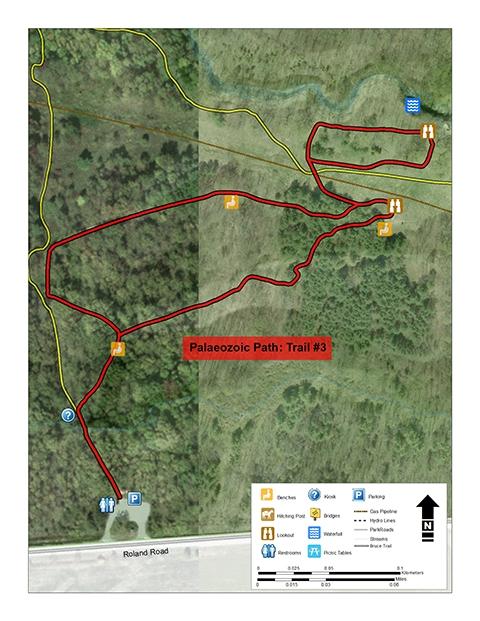
PALAEOZOIC PATH
Trail Type: Physically Challenged, and Hikers
Trail Marker: Red #3
Trail Length: 0.8 km (30 minutes)
Trail Difficulty: Gentle Slopes with wide Gravel Path
The Paleozoic Path was designed to give people with disabilities and beginner hikers an opportunity to experience the park. The path has a hard gravel surface suitable for wheelchairs and baby strollers and offers several barrier-free benches with scenic views. Mountain bikers and horseback riders are not permitted on this trail. With a low level of difficulty this path is an educational wonder. The trail contains a viewing platform for a breathtaking look at Swayze Falls. Some of the notable features along the path include Norway Spruce, Hard Maple, White Pine, Apple and a variety of other species. This trail converges with the Swayze Falls trail and can only be accessed from Roland Road.
SCARLET TANAGER
Trail Type: Hikers Only – eastern portion closed
Trail Marker: Blue #4
Trail Length: 2.3 km (1 hour)
Trail Difficulty: Moderate to Difficult
The Scarlet Tanager Trail can be accessed from the Pelham Road entrance. The start of the trail begins at the bottom of Gilligan Road (gravel road). This trail consists of varied terrain, adding to its difficulty. Mountain bikers and horseback riders are not permitted on this trail as it is a hiking only trail. Some of the notable features include White Pine and Maple trees which provide habitat for Scarlet Tanagers and other bird species. There is access to the Hemlock Valley trail from the southern end of this trail. Hikers should take into consideration that the walk from Pelham Road parking lot to the trail head is approximately 15 minutes, adding to the overall hiking time on this trail.
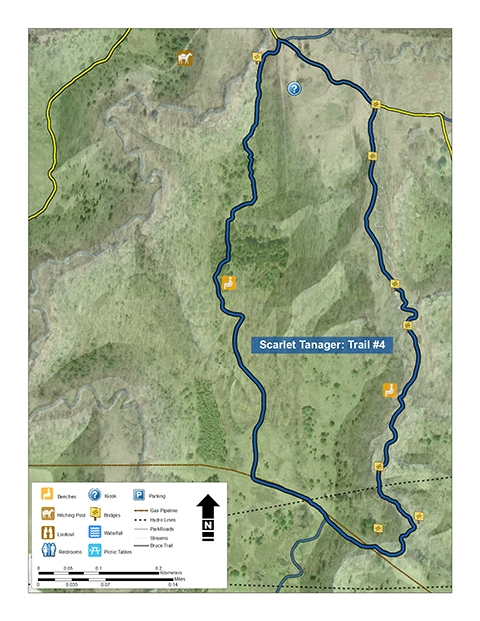
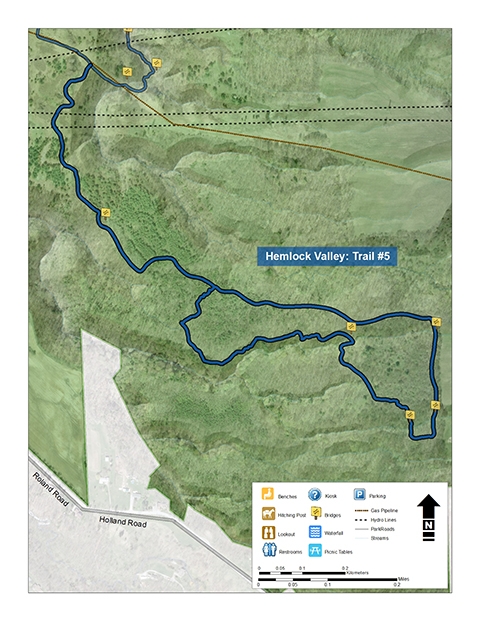
HEMLOCK VALLEY
Trail Type: Hikers Only
Trail Marker: Blue #5
Trail Length: 2.8 km (2 hours)
Trail Difficulty: Moderate
The Hemlock Valley Trail, a natural terrain trail, accommodates the moderate hiker. Mountain bikers and horseback riders are not permitted on this trail. This trail can only be accessed from the Scarlet Tanager Trail. It will take about 30 minutes to reach the trail head. The most notable feature along this trail is the rare Hemlock stand found in this section of the park. Other features include an old harrow and many rock piles which provide evidence of farming activities in the past. Wildlife seen along this trail includes White-tailed deer and wild turkey.
TERRACE CREEK
Trail Type: Hikers Only
Trail Marker: Blue #6
Trail Length: 4.6 km (2 hours)
Trail Difficulty: Difficult
The Terrace Creek Trail extends along a natural terrain path which can be accessed via the Black Walnut Trail, either from the end of Gilligan Road or Old Farm Road which runs from the Wiley Road parking lot. This trail consists of varying ground and will take approximately 30 minutes from the Pelham Road parking lot to reach the start of this trail. Mountain Bikers and Horseback Riders are not permitted on this trail. Some of the notable features along this trail include Cataract Woods, Terrace Creek waterfall, and a variety of wildlife habitats.

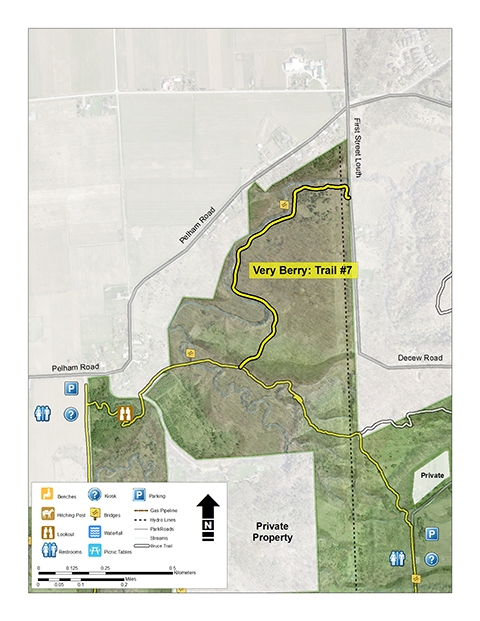
VERY BERRY TRAIL
Trail Type: Shared Use
Trail Marker: Yellow #7
Trail Length: 2.6 km (1 hour)
Trail Difficulty: Moderate to Difficult
The Very Berry Trail is a shared-use trail for hikers, horseback riders and mountain bikers. This natural terrain path can be accessed from the Pelham Road entrance. The trail begins about .5 kilometers or 15 minutes from the parking lot along the northeast section of the Black Walnut Trail. The trail extends to the eastern park boundary; from this point the hiker must retrace his footsteps for a total round trip of approximately 2.6 kilometers which takes about 1 hour. While part of the trail is easy, several hills can make this a moderate to difficult hike.
The first part of the trail follows the remains of an old farmer’s road, known as the Hog’s Back. In earlier times, it was probably used to haul materials through the valley to and from the mills at Power Glen and to avoid the steep hill on today’s First Street Louth. The main feature of the trail is the meandering Twelve Mile Creek, Niagara’s only cold-water creek, historically noted for its quality trout fishing. The river bank and flood plain also provide a home to birds and various small mammals.
Natural vegetation include a mix of Basswood, Beech, Maple, Oak and Ironwood in the upland areas and large Bitternut Hickory and Black Walnut trees in the valley. Stands of White Pine and Spruce open into grassland. Woodland Sunflowers, False Solomon’s Seal, Vervain and Snakeroot, ferns, White Baneberry or “Dolls Eyes,” and Touch-Me-Not are some of the wildflowers that dapple the edges of the trail in this idyllic setting.
Guidelines for a Pleasant Visit
Short Hills Provincial Park is classified as a non-operating park. This means admission is free but there are few amenities. Visitors are asked to respect the rules of the park. These are:
- The park is open seven days a week.
- The park closes at dusk each day and reopens at sunrise.
- Camping is not permitted in the park.
- No cooking fires or campfires are allowed in the park.
- Alcoholic beverages are not to be consumed in the park or the parking lots.
- Motorized vehicles including trail bikes are not allowed in the park.
- Dogs are welcome in the park but must be kept on a leash.
- Dog feces must be removed from the park and disposed of in the garbage at the park entrances. Dog fece bags are supplied at the park entrances.
- Cutting or removal of trees or plants is not permitted.
- Please carry out what you carry in. Trash barrels are located at each parking lot.
- Visitors are asked to remain on established trails.
- Toilets are located at the Pelham, Roland and Wiley Road parking lots.
Trail Etiquette
The trail system in Short Hills Provincial Park welcomes horseback riders, cyclists and hikers.
Please note that each of the seven established trails is designated as either shared use (horses, cyclists and hikers), hikers and physically challenged, or hikers only. Please refrain from using trails not designated for your form of transportation.
Code of Ethics
As a visitor and a friend of Short Hills Park, I understand that:
- The park is a unique, natural environment to be preserved for its owns sake, as well as for future generations.
- My responsibility is of a caretaker, to actively seek to promote the ecological health and diversity of the park. I pledge to:
- show respect; tread lightly.
- pack out what is packed in.
- keep wildlife wild, by observing from a safe and non- interfering distance.
- observe, not disturb natural features in the park; memories outlast specimens.
- preserve peace in the park; be considerate to others.
- protect the park from disruptive activities, such as open fires or vandalism.
- become better informed about the needs of Short Hills Provincial Park, and share my knowledge with others.
- to remain on established trails.
- to not use the park or the trails when wet conditions apply.
You must be logged in to post a comment.